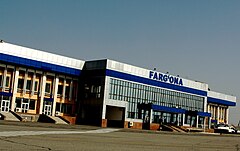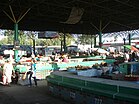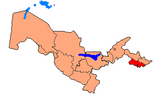Fergana
You can help expand this article with text translated from the corresponding article in Russian. (March 2024) Click [show] for important translation instructions.
|
This article needs additional citations for verification. (March 2024) |
Fergana
Fargʻona / Фарғона | |
|---|---|
| Coordinates: 40°23′11″N 71°47′11″E / 40.38639°N 71.78639°E | |
| Country | |
| Region | Fergana Region |
| Established | 1876 |
| Government | |
| • Type | City Administration |
| • Hakim (Mayor) | Vosiljon Nazarov |
| Area | |
| • Total | 95.6 km2 (36.9 sq mi) |
| Elevation | 590 m (1,940 ft) |
| Population (2022)[1] | |
| • Total | 299,200 |
| • Density | 3,100/km2 (8,100/sq mi) |
| Area code | (+998) 73 |
| Website | ferghana |
Fergana (Uzbek: Fargʻona, Фарғона, pronounced [farʁɒna]), (Persian: فرغانه) or Ferghana, also Farghana is a district-level city and the capital of Fergana Region in eastern Uzbekistan.[2] Fergana is about 320 km east of Tashkent, about 75 km southwest of Andijan, and less than 20 km from the Kyrgyzstan border. The modern city was founded in 1876.
History
[edit]
Fergana first appears in written records in the 5th-century. However, archeological evidence demonstrates that the city had been populated since the Chalcolithic period. Like many other Central Asian places in the sixth and seventh-centuries, Fergana was ruled by the Western Turkic Khaganate. Although it was still predominantly inhabited by eastern Iranians, many Turks had also started to settle there.[3] The city of Fergana was refounded in 1876 as a garrison town and colonial appendage to Margilan (22 kilometres or 13+1⁄2 miles to the northwest) by the Russian Empire.[citation needed]
Fergana Region is one of the centers of ancient culture in Uzbekistan. Photographs of Stone Age settlements and rocks found in the area show that stone tools have been used by people in the valley since ancient times. Excavations of the Great Fergana Canal have played an important role in the study of archaeological monuments in the region. During the excavation of the canal, monuments from the Bronze Age, slavery and land ownership were discovered and studied. Finds from the 5th century BC and early medieval period in the town of Quva are well studied. Historical sources from the 10th to 11th century state that this city was the largest and most prosperous in the valley after Akhsikath. Archaeological materials confirm that the city of Margilan was a large village in the 10th century and took on the appearance of a hamlet in the 11th and 12th centuries.
The monuments found in the settlements of the Chust culture, engaged in sedentary agriculture and animal husbandry, are important for the study of the Fergana Valley. Archaeological excavations show that the Fergana Region has long been inhabited by people engaged in hunting, farming, animal husbandry, and at later stages of the existence of human society, culture began to develop.
It was initially named New Margelan (Russian: Новый Маргелан), then renamed Skobelov (Скобелев) in 1907 after the first Russian military governor of the Fergana Valley, Mikhail Skobelev. In 1924, after the Soviet Union's reconquest of the region from the Basmachi movement, the name was changed to Fergana, after the province of which it was the centre.[4]
During World War I, the city was the location of a Russian prisoner-of-war camp for German and Austro-Hungarian POWs, including ethnic Polish conscripts, many of whom died to typhus.[5]
The industrial base of Fergana was developed in the 20th century. Industry in the city included textile manufacturing and a nitric fertiliser plant. Some of the industrial development was a result of Evacuation in the Soviet Union during World War II.[6]

Fergana has been a center for oil production in the Fergana Valley since the region's first oil refinery was built near the city in 1908. Since then, more refineries have been added, and Fergana is one of the most important centers of oil refining in Uzbekistan. Natural gas from western Uzbekistan is transported by pipeline to the valley, where it is used to manufacture fertilizer. The Great Fergana Canal, built almost entirely by hand during the 1930s, passes through the northern part of the city and was completed in 1939. During its construction, the canal and the city were widely photographed by the noted photographer Max Penson. With a western loan Fergana is able to modernize its refinery and also reduce air pollution[7] emissions.
Climate
[edit]Fergana has a cool arid climate (Köppen BWk). Winters are cold and short, with a daily average low temperature of −2.6 °C (27.3 °F) and a daily average high of 4.8 °C (40.6 °F) in January; summers are hot, with an average low temperature of 20.6 °C (69.1 °F) and an average high of 35.1 °C (95.2 °F) in July. Annual precipitation is less than 188.1 millimetres or 7 inches, and most of this falls in winter and spring.
| Climate data for Fergana (1991-2020, extremes 1881-present) | |||||||||||||
|---|---|---|---|---|---|---|---|---|---|---|---|---|---|
| Month | Jan | Feb | Mar | Apr | May | Jun | Jul | Aug | Sep | Oct | Nov | Dec | Year |
| Record high °C (°F) | 16.3 (61.3) |
23.1 (73.6) |
29.0 (84.2) |
34.4 (93.9) |
39.2 (102.6) |
41.3 (106.3) |
42.2 (108.0) |
41.4 (106.5) |
37.1 (98.8) |
32.6 (90.7) |
29.0 (84.2) |
17.6 (63.7) |
42.2 (108.0) |
| Mean daily maximum °C (°F) | 4.8 (40.6) |
8.0 (46.4) |
15.4 (59.7) |
22.5 (72.5) |
28.1 (82.6) |
33.2 (91.8) |
35.1 (95.2) |
33.9 (93.0) |
29.2 (84.6) |
21.4 (70.5) |
12.9 (55.2) |
6.3 (43.3) |
20.9 (69.6) |
| Daily mean °C (°F) | 0.5 (32.9) |
3.2 (37.8) |
9.9 (49.8) |
16.3 (61.3) |
21.4 (70.5) |
25.9 (78.6) |
27.8 (82.0) |
26.3 (79.3) |
21.2 (70.2) |
14.1 (57.4) |
7.1 (44.8) |
1.9 (35.4) |
14.6 (58.3) |
| Mean daily minimum °C (°F) | −2.6 (27.3) |
−0.5 (31.1) |
5.3 (41.5) |
10.6 (51.1) |
15.0 (59.0) |
18.7 (65.7) |
20.6 (69.1) |
19.1 (66.4) |
14.3 (57.7) |
8.4 (47.1) |
2.8 (37.0) |
−1.2 (29.8) |
9.2 (48.6) |
| Record low °C (°F) | −25.8 (−14.4) |
−25.5 (−13.9) |
−17.9 (−0.2) |
−4.8 (23.4) |
1.2 (34.2) |
7.4 (45.3) |
10.1 (50.2) |
7.8 (46.0) |
0.5 (32.9) |
−7.4 (18.7) |
−22.8 (−9.0) |
−27.0 (−16.6) |
−27.0 (−16.6) |
| Average precipitation mm (inches) | 16 (0.6) |
22 (0.9) |
25 (1.0) |
23 (0.9) |
22 (0.9) |
14 (0.6) |
5 (0.2) |
4 (0.2) |
4 (0.2) |
14 (0.6) |
19 (0.7) |
22 (0.9) |
190 (7.7) |
| Average rainy days | 4 | 7 | 10 | 10 | 13 | 10 | 8 | 5 | 4 | 6 | 7 | 6 | 90 |
| Average snowy days | 7 | 5 | 1 | 0.1 | 0.03 | 0.03 | 0.03 | 0 | 0 | 0.3 | 1 | 5 | 19 |
| Average relative humidity (%) | 81 | 76 | 67 | 61 | 56 | 48 | 48 | 52 | 56 | 66 | 74 | 82 | 64 |
| Mean monthly sunshine hours | 90.0 | 105.3 | 162.3 | 214.6 | 269.9 | 314.3 | 340.4 | 315.6 | 276.2 | 206.5 | 128.4 | 89.7 | 2,513.2 |
| Source 1: Pogoda.ru.net[8] | |||||||||||||
| Source 2: NOAA[9] | |||||||||||||
Population
[edit]As of January 1, 2014, the city had a population of 340,600,[10] making it the 3rd largest city in the Fergana Valley.
The town was Russian for the first time after its foundation. In 1911 its population consisted of 11,892 people. Of them Russians were 7,534 (63%), Sarts were 2,590 (22%).[11] According to the 1926 census, of the 14,275 inhabitants in the city, there were 7,942 Russians (55%), 667 were Ukrainians (4.6%), and 514 were Jews (3.6%), while there were only 3,011 Uzbeks (21.0%).[12]
As of 2013, Fergana is virtually mono-ethnic - of the city's 350,600 residents, 316,268 are Uzbek (90.0%).
In addition to Uzbeks, 12,084 Russians (3.4%), 3,114 Tajiks (1.1%), 2,028 Koreans (0.7%), and 626 Tatars (0.2%) also live in Fergana. There are also Azerbaijanis, Armenians, Jews, Germans and representatives of other nations.
Demographics
[edit]The population of Fergana city is approximately 321,800 as of 2024, was 314,400 as of 2023, and 299,200 as of 2022.[1] Uzbeks are the largest ethnic group, with Russian-speakers comprising about 25% of the city's population.[6]
Sport
[edit]Thanks to independence, Uzbek sport is developing. Sports are becoming more and more popular in all regions of the country. The fact that in recent years world and Asian champions in various sports have appeared in Fergana Region testifies to the fact that physical culture and sports are becoming more and more popular among Fergana residents, especially among the youth. In 1991 there were only 17 stadiums in Fergana region, now there are 46,759 football fields and 33 modern tennis courts. Many sports facilities have been built in Fergana, such as Istiklol tennis complex, Kimyogar complex, swimming pool and Istiklol stadium, equipped with equipment that fully meets the world standards.
Culture
[edit]Architecture
[edit]Fergana has a high proportion of Russians, Soviet Koreans and Tatars compared to other Fergana Valley cities. With its wide, tree-lined boulevards and Russian Empire-era buildings, and the Russian language spoken frequently on the streets, the city has a distinctly different feel from the rest of the region.[13]
-
Chapel to Alexander Nevsky
-
City center
-
River
Main sights
[edit]- Museum of Local Studies — with displays of natural history, photographs, and local handicrafts
- Regional Theatre — in 1877 the house of General Mikhail “Old Bloody Eyes” Skobelev
- Fergana State University — built in 1902
Notable people
[edit]- Shamshad Abdullaev — male Soviet and post-Soviet Uzbek author and poet
- Anastasiya Miroshnichenko — female artistic gymnast
- Xudoyberdi To'xtaboyev — male Soviet and post-Soviet Uzbek author
- Ziroat Mirziyoyeva — First Lady of Uzbekistan
- Peter Mikhailovich Kulakov — male Soviet and post-Soviet television evangelist for the Seventh-day Adventist Church
- Ida Mayrin — Uzbek-Israeli Olympic rhythmic gymnast
- Yadgar Nasriddinova — female Soviet Uzbek engineer and member of the Supreme Soviet of the Soviet Union
- Abdulla Qahhor — Soviet Uzbek writer
- Hamza Hakimzade Niyazi — Imperial Russian and Soviet poet and playwright
- Saida Mirziyoyeva — politician, eldest daughter of the President of Uzbekistan
- Furqat — poet in the Russian Empire exiled to Chinese Turkestan
Sports clubs
[edit]See also
[edit]References
[edit]- Hill, John E. (2009) Through the Jade Gate to Rome: A Study of the Silk Routes during the Later Han Dynasty, 1st to 2nd Centuries CE. John E. Hill. BookSurge, Charleston, South Carolina. ISBN 978-1-4392-2134-1.
- Watson, Burton. Trans. 1993. Records of the Grand Historian of China: Han Dynasty II. Translated from the Shiji of Sima Qian. Chapter 123: "The Account of Dayuan," Columbia University Press. Revised Edition. ISBN 0-231-08166-9; ISBN 0-231-08167-7 (pbk.)
- Jean-Marie Thiébaud, Personnages marquants d'Asie centrale, du Turkestan et de l'Ouzbékistan, Paris, L'Harmattan, 2004. ISBN 2-7475-7017-7.
References
[edit]- ^ a b "Hududlar bo'yicha shahar va qishloq aholisi soni" [Urban and rural population by district] (PDF) (in Uzbek). Fergana regional department of statistics.
- ^ "Classification system of territorial units of the Republic of Uzbekistan" (in Uzbek and Russian). The State Committee of the Republic of Uzbekistan on statistics. July 2020.
- ^ Bosworth 1999.
- ^ Dates of renaming taken from Adrian Room, Placenames of the World: Origins and Meanings of the Names for Over 5000 Natural Features, Countries, Capitals, Territories, Cities and Historical Sites, McFarland, 1997, ISBN 0-7864-1814-1 (pbk) p.124
- ^ Sula, Dorota (2017). "Pomoc Polakom – jeńcom w Imperium Rosyjskim w okresie I wojny światowej". Łambinowicki rocznik muzealny (in Polish). 40. Opole: 94. ISSN 0137-5199.
- ^ a b Flynn, Moya; Kosmarskaya, Natalya; Sabirova, Guzel (November 2014). "The Place of Memory in Understanding Urban Change in Central Asia: The Cities of Bishkek and Ferghana". Europe-Asia Studies. 66 (9): 1501–1524. doi:10.1080/09668136.2014.957926. S2CID 153602375.
- ^ Uzbekistan's Fergana Refinery is upgraded with EBRD finance 1997 Archived 2007-12-13 at the Wayback Machine
- ^ КЛИМАТ УЛАН-БАТОРА (in Russian). Pogoda.ru.net. Retrieved 4 January 2015.
- ^ "Climate Normals for Fergana". National Oceanic and Atmospheric Administration. Retrieved 1 November 2023.
- ^ https://web.archive.org/web/20141014235825/http://www.stat.uz/upload/str2.jpg [bare URL image file]
- ^ Статистический обзор Ферганской области за 1911 год. Скобелев. 1914.
- ^ Цыряпкина Ю. Н. Русские в Узбекистане: языковые практики и самоидентификации (на примере полевых исследований в Фергане)//Томский журнал лингвистических и антропологических исследований. 2015 год. № 3(9), с. 20
- ^ "Fergana travel guide". Caravanistan. Retrieved 2019-09-26.
Sources
[edit]- Bosworth, C. Edmund (1999). "Farḡāna". Encyclopædia Iranica, online edition. New York.
{{cite encyclopedia}}: CS1 maint: location missing publisher (link)
External links
[edit]- Official website (in Uzbek)
- Official website (in English)














